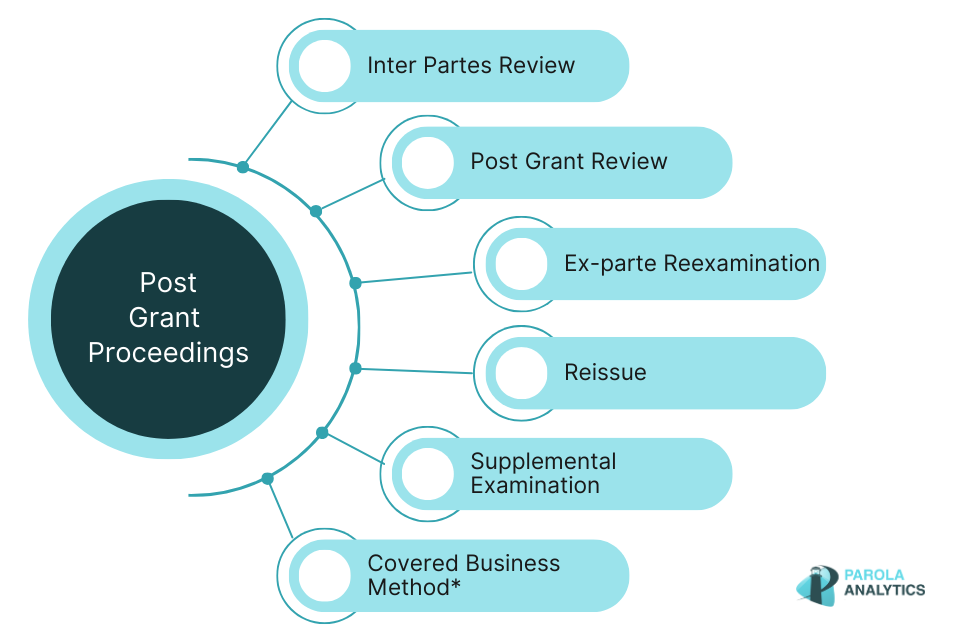Receiving a patent is never the finish line.
Even after a grant of a patent, many patent holders can still find themselves in legal risks as the validity of their patent can still be challenged.
Post-grant proceedings, some of which are overseen by the USPTO Patent Trial and Appeal Board (PTAB) provide an “administrative mechanism” for challenging the validity of a granted patent, with the goal of correcting the errors made during the patent examination and ensuring that only valid patents can be enforced. They are conducted before administrative patent judges, not juries, and follow specific rules and regulations established by the USPTO.
Businesses who find themselves in patent infringement suits can have the option to petition for a post-grant proceeding to challenge the validity of the patent asserted against them. These proceedings offer a faster and less expensive route compared to court litigation.
In this guide, we’ll explore the different post-grant proceedings available at the USPTO.

A post-grant review (PGR) allows a third party to challenge the patentability of one or more claims of an issued patent. A PGR can only be filed within 9 months from the grant of a patent or issuance of a reissue patent.
The PGR was introduced as part of the America Invents Act (AIA) in 2011 and is applicable to patents filed on or after March 16, 2013.
Grounds
During the process, the petitioner (third-party challenging the patent) asks the PTAB to review the patent’s claims based on invalidity grounds including lack of novelty, ineligible subject matter, obviousness, lack of enablement or written description, or double patenting. The best mode requirement is an exception. See § 282(b)(2) or (3).
Timing
A PGR can only be filed within 9 months from the grant of a patent or reissue patent. The patent owner can respond to the petition and the PTAB will decide whether or not to institute a trial. If the PTAB decides to proceed, both parties will have an opportunity to present evidence and arguments to support their respective positions.
An inter partes review (IPR) is a post-grant proceeding conducted before the PTAB to review the validity of one or more claims of a patent. An IPR can be initiated 9 months after patent issuance. This proceeding can be initiated by any party who is not the patent owner, and provides a mechanism for challenging the validity of a patent without going to court.
IPRs were introduced as part of the America Invents Act (AIA), and have become an increasingly popular tool for companies to challenge the validity of patents held by their competitors. On average, it typically takes between 12-18 months to reach a final decision.
Timing
An inter partes review can only be initiated after the patent has been issued and can be used to challenge patents on grounds of novelty and non-obviousness (raised under §§ 102 or 103) and based only on prior art patents and printed publications.
Process
The process starts when a third party, who is not the owner of the patent submits a petition (1) 9 months after the grant of the patent or issuance of a reissue patent, or (2) after the end of a post-grant review (if one is initiated), whichever is later. These time limits do not apply to first-to-invent (FTI) patents. The petitioner must file for an IPR within one year of being served with a complaint alleging infringement of the patent.
In an IPR, the petitioner must present evidence that the claims in the patent are invalid based on prior art consisting of patents and printed publications.
The patent owner has the opportunity to respond to the petition and present evidence in support of the validity of their claims. The PTAB then conducts a hearing and issues a final written decision as to the validity of the challenged claims.
Overall, an IPR can be a powerful tool for parties looking to challenge the validity of a patent, but it requires a thorough understanding of the complex legal and procedural rules governing these proceedings.
One key step in preparing for an IPR petition is identifying prior art that can challenge the patent’s validity. A patent validity or invalidity search is performed in this case, by looking invalidating prior art.
Find out how you can get started on a patent validity or invalidity search.
In an ex-parte reexamination, any individual is allowed to initiate a request for a second examination of one or more claims of the patent. Unlike the IPR and PGR, this review can be petitioned at any time during the period of the patent’s enforceability.
While the IPR and PGR are conducted before the PTAB, an ex-parte reexamination is conducted by the USPTO Central Reexamination Unit (CRU).
For an ex-parte reexamination request to be granted, there must be a substantial new question (SNQ) of patentability pertaining to at least one claim. The SNQ forces the requester to produce evidence that may question the patent’s validity. For this type of proceeding, third parties are excluded from participating in the proceedings and decisions must be rendered within 3 months of filing followed by the prompt handling of the remaining proceedings.
The reexamination usually proceeds until its conclusion and the potential issuance of a reexamination certificate. Amendments that broaden the scope of a claim are not allowed and all files pertaining to the reexamination are generally accessible by the public.
Key Benefits
A CBM review or a Transitional Program for Covered Business Method Patents (TPCBM), was a trial proceeding to challenge patents that cover a method or apparatus used in the practice, administration, or management of a financial product or service.
The CBM review was only available for patents filed on or after September 16, 2012. Under the AIA, a patent for a “technological invention” is excluded from this proceeding.
A petition for CBM may be filed based on any ground of invalidity, including sections 101, 112, and, to a certain extent, sections 102 and 103. The scope of prior art that can be considered is limited for covered business method patents granted under first-to-invent provisions. In cases where a petitioner challenges the validity of one or more claims in a covered business method patent that has an effective filing date before March 16, 2013, they can only rely on prior art defined by pre-AIA 35 U.S.C. §102.
While CBM offers several benefits for the patents covered in this proceeding, AIA applied a sunset period to TPCBM. The last batch of new petitions for this proceeding was accepted last September 16, 2020.
A reissue proceeding is used to correct errors in the patent. This is requested by a patent owner when if the error causes the patent to be “deemed wholly or partly inoperative or invalid, by reason of a defective specification or drawing, or by reason of the patentee claiming more or less than he had a right to claim in the patent.”
This review, which is must be initiated two years after the issuance of the patent, is conducted by a patent examiner.
An effective prior art search is a critical step in post-grant proceedings. The petitioner is required to identify prior art references that are relevant to the claims of the patent and which could potentially invalidate them.
In an IPR, the petitioner is required to provide a detailed explanation of how the prior art references are relevant to the claims of the patent in question. The PTAB relies heavily on the petitioner’s prior art search and analysis to determine whether the claims of the patent are unpatentable.
The PGR however, allows for a wider range of grounds for invalidating a patent, such as lack of enablement or inadequate written description, and not just based on prior art.
It is recommended to consult with a patent attorney for a more thorough evaluation of your case. Professional patent search firms may offer valuable expertise in looking for relevant prior art.
The Parola Advantage
Parola Analytics’ prior art search services is led and reviewed by U.S. patent attorneys. This can offer better quality results and more relevant references. By covering both the technical research and legal fronts, it can offer more cost-effective solutions to either petitioner or defendant.
Find out more about what our clients have to say here.

The first search Parola Analytics, Inc. performed for us provided the key reference supporting our invalidity position on a patent we were evaluating.”
Sean M. Dean, Ph.D
Fish & Richardson

Parola Analytics was able to quickly provide us with a key prior art reference despite other search vendors failing to find anything useful. Parola’s thorough search report also provided detailed analysis and allowed us to easily assess the viability of the references and efficiently create invalidity contentions.
Luc Dahlin
Goodwin Procter
Services
Links
Sign up to receive first access to our reports, the latest patent news, and other updates —
all delivered to your inbox.
Sign up now to receive monthly patent news, analysis and free insight reports.
We don’t spam, we promise.